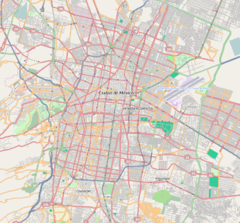Castle of Chapultepec
| Chapultepec Castle | |
|---|---|
| Castillo de Chapultepec | |

View of Chapultepec Castle from the Northeast
|
|
|
|
|
| General information | |
| Architectural style | Neo-romanticism, Neoclassical, Neo-Gothic |
| Location | Miguel Hidalgo, Mexico City, Mexico |
| Coordinates | 19°25′14″N 99°10′54″W / 19.42056°N 99.18167°W |
| Elevation | 2,325 metres (7,628 ft) above sea level |
| Current tenants | Museo Nacional de Historia |
| Construction started | c. 1785 |
| Completed | 1863 |
| Height | 220 feet (67 m) |
| Design and construction | |
| Architect | Eleuterio Méndez, Ramón Cruz Arango ity, Julius Hofmann, Carl Gangolf Kayser, Carlos Schaffer |
| Other designers | Maximilian I of Mexico |
Chapultepec Castle (Spanish: Castillo de Chapultepec) is located on top of Chapultepec Hill. The name Chapultepec stems from the Nahuatl word chapoltepēc which means "at the grasshopper's hill". It is located in the middle of Chapultepec Park in Mexico City at a height of 2,325 meters (7,628 ft) above sea level. The site of the hill was a sacred place for Aztecs, and the buildings atop it have served several purposes during its history, including that of Military Academy, Imperial residence, Presidential home, observatory, and presently, the National Museum of History.
It is the only royal castle in mainland North America that was actually used as the residence of a sovereign: the Mexican Emperor Maximilian I, and his consort Empress Carlota, lived there during the Second Mexican Empire. The first Emperor Agustín de Iturbide did not serve long enough to establish a imperial residence.
In 1785 Viceroy Bernardo de Gálvez ordered the construction of a stately home for himself at the highest point of Chapultepec Hill. Francisco Bambitelli, Lieutenant Colonel of the Spanish Army and engineer, drew up the blueprint and began the construction on August 16 of the same year.
After Bambitelli's departure to Havana, Captain Manuel Agustín Mascaró took over the leadership of the project and during his tenure the works proceeded at a rapid pace. Mascaró was accused of building a fortress with the intent of rebelling against the Spanish Crown from there. Bernardo, the viceroy, died suddenly on November 8, 1786, fueling speculation that he was poisoned. No evidence has yet been found which supports this claim.
...
Wikipedia

